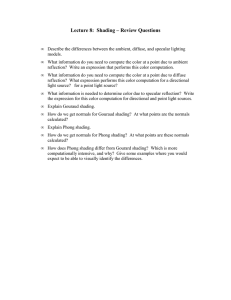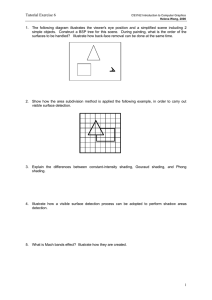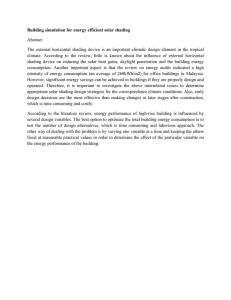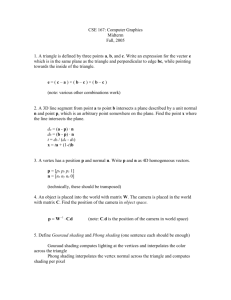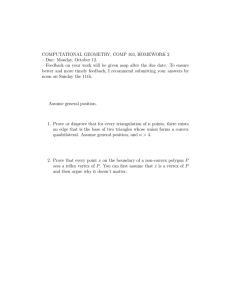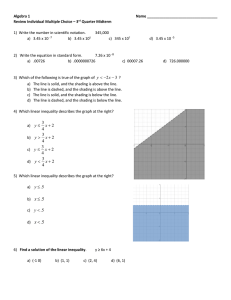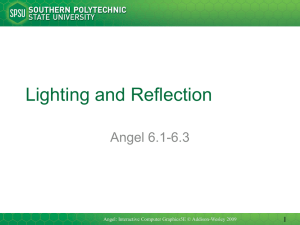Vectors, Normals, & Shading Angel 6.4-6.5 1
advertisement
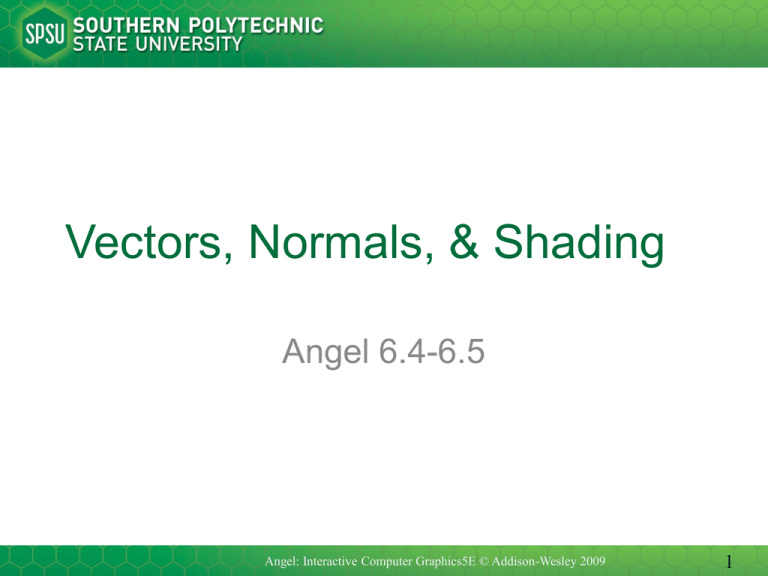
Vectors, Normals, & Shading Angel 6.4-6.5 Angel: Interactive Computer Graphics5E © Addison-Wesley 2009 1 Objectives • Discuss vectors & normals • Introduce the OpenGL shading functions • Discuss polygonal shading – Flat – Smooth – Gouraud Angel: Interactive Computer Graphics 5E © Addison-Wesley 2009 2 Steps in OpenGL shading • • • • Enable shading and select model Specify normals Specify material properties Specify lights Angel: Interactive Computer Graphics 5E © Addison-Wesley 2009 3 Normal for Triangle n plane p2 n ·(p - p0 ) = 0 n = (p2 - p0 ) ×(p1 - p0 ) normalize n n/ |n| p p1 p0 Note that right-hand rule determines outward face Angel: Interactive Computer Graphics 5E © Addison-Wesley 2009 4 Normals and Gradients • For a non-linear surface, we can find the plane where the normal to this plane is the gradient. • Doing this many times across the surface allows us to do shading… n p Angel: Interactive Computer Graphics5E © Addison-Wesley 2009 5 Normals • In OpenGL the normal vector is part of the state • Set by glNormal*() – glNormal3f(x, y, z); – glNormal3fv(p); • Usually we want to set the normal to have unit length so cosine calculations are correct – Length can be affected by transformations – Note that scaling does not preserved length – glEnable(GL_NORMALIZE) allows for autonormalization at a performance penalty Angel: Interactive Computer Graphics 5E © Addison-Wesley 2009 6 Enabling Shading • Shading calculations are enabled by – glEnable(GL_LIGHTING) – Once lighting is enabled, glColor() ignored • Must enable each light source individually – glEnable(GL_LIGHTi) i=0,1….. • Can choose light model parameters – glLightModeli(parameter, GL_TRUE) • GL_LIGHT_MODEL_LOCAL_VIEWER do not use simplifying distant viewer assumption in calculation • GL_LIGHT_MODEL_TWO_SIDED shades both sides of polygons independently Angel: Interactive Computer Graphics 5E © Addison-Wesley 2009 7 Polygonal Shading • Shading calculations are done for each vertex – Vertex colors become vertex shades • By default, vertex shades are interpolated across the polygon – glShadeModel(GL_SMOOTH); • If we use glShadeModel(GL_FLAT); the color at the first vertex will determine the shade of the whole polygon Angel: Interactive Computer Graphics 5E © Addison-Wesley 2009 8 Polygon Normals • Polygons have a single normal – Shades at the vertices as computed by the Phong model can be almost same – Identical for a distant viewer (default) or if there is no specular component • Consider model of sphere • Want different normals at each vertex even though this concept is not quite correct mathematically Angel: Interactive Computer Graphics 5E © Addison-Wesley 2009 9 Smooth Shading • We can set a new normal at each vertex • Easy for sphere model – If centered at origin n = p • Now smooth shading works • Note silhouette edge Angel: Interactive Computer Graphics 5E © Addison-Wesley 2009 10 Mesh Shading • The previous example is not general because we knew the normal at each vertex analytically • For polygonal models, Gouraud proposed we use the average of the normals around a mesh vertex n = (n1+n2+n3+n4)/ |n1+n2+n3+n4| Angel: Interactive Computer Graphics 5E © Addison-Wesley 2009 11 Gouraud and Phong Shading • Gouraud Shading – Find average normal at each vertex (vertex normals) – Apply modified Phong model at each vertex – Interpolate vertex shades across each polygon • Phong shading – – – – Find vertex normals Interpolate vertex normals across edges Interpolate edge normals across polygon Apply modified Phong model at each fragment Angel: Interactive Computer Graphics 5E © Addison-Wesley 2009 12 Comparison • If the polygon mesh approximates surfaces with a high curvatures, Phong shading may look smooth while Gouraud shading may show edges • Phong shading requires much more work than Gouraud shading – Until recently not available in real time systems – Now can be done using fragment shaders (see Chapter 9) • Both need data structures to represent meshes so we can obtain vertex normals Angel: Interactive Computer Graphics 5E © Addison-Wesley 2009 13
